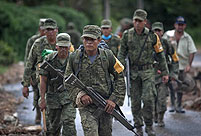South Korea decided on Tuesday to reject Boeing's F-15 Silent Eagle as the country's next-generation fighter jet because the candidate was assessed not to have enough combat capabilities against possible provocations from the Democratic People's Republic of Korea (DPRK).
Among three candidates, including Lockheed Martin's F-35 stealth jet and EADS' Eurofighter Tranche 3 Typhoon, Boeing's F-15 SE was selected as the last candidate for the country's next- generation fighter, but it was rejected at the meeting of the defense acquisition committee presided over by Defense Minister Kim Kwan-jin, the Defense Acquisition Program Administration (DAPA) said in a statement on Tuesday.
The arms procurement agency said that it will restart the project as early as possible, which was expected to take more than one year to resume the acquisition process, in order to minimize security vacuum.
South Korea had pushed an 8.3 trillion won (7.2 billion U.S. dollars) deal to buy 60 fighter jets, the largest arms import contract in the country's history, to replace the aging fleets of F-4s and F-5s for five years from 2017.
Boeing's F-15 SE was the sole candidate that fell within the budget of 8.3 trillion won, but it was not selected due to its lack of stealth features. Former Air Force chiefs have expressed concerns over the aircraft's stealth functions.
"The fighter jet project will be restarted given the asymmetric threat such as North Korea (DPRK)'s nuclear threat, recent security situation and rapid development of aeronautical technology," Kim Min-seok, spokesman of the Defense Ministry, told a press briefing.
Kim said that the South Korean Air Force would need enhanced combat capabilities given the recent trend of aviation technology change into the fifth-generational fighter jets, noting that retaliatory tools against the DPRK's possible provocations would be necessary as the core tool of the kill chain system.
The kill chain framework, also dubbed an attacking style of defense system, is a process that detects nuclear and missile attacks by the DPRK on a real-time basis before targeting and neutralizing the attacks.
 Storms leave 97 dead, 58 missing in Mexico
Storms leave 97 dead, 58 missing in Mexico New model of indigenous surface-to-air missiles testfired
New model of indigenous surface-to-air missiles testfired  118.28-carat diamond to be auctioned in HK
118.28-carat diamond to be auctioned in HK Maternal love under streetlight
Maternal love under streetlight Naked foreign student sits in the middle of a road in Haikou
Naked foreign student sits in the middle of a road in Haikou  Colorful Yunnan: Enjoy the natural beauty
Colorful Yunnan: Enjoy the natural beauty Harbin named Chinese city with most beautiful women
Harbin named Chinese city with most beautiful women New college students' military training in Guangzhou
New college students' military training in Guangzhou Rugby girls
Rugby girls PLA's 38th Group Army conduct training
PLA's 38th Group Army conduct training Residences of the royal house of Savoy
Residences of the royal house of Savoy The last days of Wan Aihua
The last days of Wan Aihua Highlights at 12th National Games of China
Highlights at 12th National Games of China Beijing Film Academy welcomes freshmen
Beijing Film Academy welcomes freshmen Large mahjong party sets new world record
Large mahjong party sets new world recordDay|Week|Month